Understanding Membrane Switches Over: The Secret to Sturdy and Reliable Controls

What Are Membrane Switches?
Membrane layer buttons are an innovative service in the realm of interface innovation, combining performance and layout seamlessly. These gadgets serve as an interface between users and digital systems, incorporating numerous parts right into a portable layout. Normally created from versatile, thin layers of products, membrane layer switches are created to respond to touch, enabling users to engage with machinery and electronic gadgets efficiently.
The main elements of a membrane switch consist of a printed circuit layer, graphic overlay, and a spacer layer that stops unplanned activation. The graphic overlay can be tailored to show brand name identity or user preferences, boosting aesthetic appeals while ensuring usability. Membrane layer buttons are generally utilized in various applications, including medical tools, consumer electronics, and industrial devices, owing to their resilience and resistance to environmental variables such as wetness and dirt.
Among the crucial benefits of membrane layer switches is their capacity to stand up to deterioration, making them perfect for high-traffic environments. In addition, they are lightweight and call for very little space, permitting for ingenious designs in item advancement. Overall, membrane layer switches stand for a useful and efficient selection for contemporary digital interfaces, marrying innovation with user-centric design principles.
Exactly How Membrane Switches Work
The operation of membrane layer switches hinges on a straightforward yet efficient device that translates customer input into electronic signals. When a user presses the switch, the top layer deforms, allowing a conductive aspect in the circuit layer to make contact with a corresponding conductive pad on the underside of the visuals overlay.
The design of membrane layer buttons can vary, but they often integrate domes or responsive aspects to provide feedback to the customer, boosting the total experience - membrane switch. The materials made use of in membrane layer buttons, such as polyester or polycarbonate, add to their durability and resistance to ecological aspects, including moisture and dirt. Furthermore, the published circuits are generally enveloped, which protects them from damage with time.
Advantages of Membrane Layer Switches

Additionally, membrane layer switches are recognized for their resilience. Created from robust products, they are immune to dirt, wetness, and physical wear, which considerably expands their lifespan contrasted to traditional mechanical buttons. This resilience makes them particularly ideal for high-traffic atmospheres and applications calling for longevity.
Another considerable advantage you could try this out is the convenience of cleansing and upkeep. The smooth surface of membrane layer switches decreases dust build-up and is typically unsusceptible spills, making them ideal for setups that call for constant sanitization.
In addition, membrane layer buttons supply a streamlined profile, bring about a thinner design that can be incorporated right into various gadgets without including bulk. This function not only improves the visual appeal yet also contributes to a much more ergonomic item layout.
Applications of Membrane Buttons
User-friendly and functional, membrane layer buttons discover applications across a wide variety of industries, including clinical devices, customer electronics, and industrial equipment. In the medical area, these switches are important to tools such as diagnostic equipment, patient monitoring systems, and infusion pumps, where dependability and ease of cleansing are vital. Their capability to maintain and hold up against harsh settings functionality makes them perfect for such applications.

In customer electronics, membrane layer buttons are made use of in products like microwaves, cleaning makers, and push-button controls - membrane switch. Their streamlined layout enables instinctive interface, boosting the overall user experience while giving durability and resistance to tear and wear
Industrial equipment likewise benefits from membrane buttons, specifically in control panels for equipment and automation systems. These buttons provide protection versus dust and dampness, find here ensuring constant performance in challenging settings. In addition, their personalized features allow suppliers to customize them to specific operational demands, improving performance and capability.
Selecting the Right Membrane Layer Switch Over
When selecting a membrane button, it is vital to take into consideration various factors that affect performance and viability for particular applications. The key factors to consider consist of environmental conditions, tactile responses, resilience, and layout specifications.
First, analyze the operating atmosphere; switches revealed to dampness, chemicals, or severe temperatures need specific materials to make sure durability and functionality. Next, evaluate the need for responsive responses. Relying on customer communication, some applications may gain from a responsive feedback to verify activation, while others might prefer a non-tactile style for visual factors.
Longevity is an additional critical element; membrane layer switches ought to be developed to stand up to frequent use, effects, and abrasion. Make certain the selected switch can endure the expected lifecycle, especially in high-usage scenarios.

Final Thought
In conclusion, membrane switches serve as vital elements in the design of trusted and long lasting control systems throughout various industries. Their small design, integrated with durable building Bonuses and construction and adjustable functions, improves customer interaction while making sure long life sought after atmospheres. The versatility of membrane layer changes enables tailored services that fulfill particular operational requirements, enhancing their value in contemporary technology. As industries continue to develop, the importance of integrating efficient membrane layer switch solutions can not be overstated.
Membrane layer switches over stand for a vital element of modern user interface style, mixing functionality with strength in numerous applications.Membrane buttons are an innovative service in the realm of user interface innovation, integrating functionality and layout perfectly. Usually constructed from versatile, slim layers of products, membrane buttons are designed to react to touch, enabling individuals to engage with machinery and digital gadgets properly.
The style of membrane buttons can differ, yet they commonly integrate domes or responsive components to provide responses to the customer, boosting the overall experience.In conclusion, membrane layer switches offer as necessary components in the style of resilient and reputable control systems throughout various sectors.
Comments on “The Role of Membrane Switches in Enhancing Device Functionality”